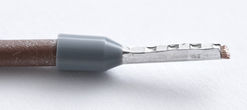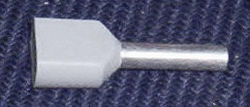Terminal block connections, recommended practice
From Sensoray Technical Wiki
The following recommendations apply to spring and screw cage terminal blocks (TBs) on Sensoray products.
Contents |
Strain relief
It is recommended to secure all wires with strain reliefs. This is especially important if the wires will be flexed or subjected to vibration or pulling forces.
Wire ferrules
Wire ferrules are recommended to prevent contact loss due to oxidation or wire deformation and, in the case of stranded wire, to avoid shorts caused by splayed or broken strands.
When choosing a ferrule, ensure that:
- Ferrule inside diameter is large enough to accommodate the wire.
- Ferrule outside diameter is not too large to fit into the TB.
A crimping tool is used to secure the wire to the ferrule. Always use the proper tool, which will:
- Crimp without damaging the ferrule or wire.
- Leave a textured surface that is readily gripped by the terminal.
To assemble:
- Insert the wire (or wires, in the case of a twin ferrule) into the ferrule and crimp.
- Insert the ferrule into the TB and tighten it in place.
Stranded wire
- Always use a wire ferrule.
- Do not insert bare strands directly into the TB.
- Do not apply solder to the strands.
Solid wire
- The use of a wire ferrule is recommended.
- It may be acceptable to insert bare wire into the TB. This should be avoided if the wire is subjected to vibration or pulling force, or if it would be significantly deformed by the compressive force of the TB jaws.
- Do not apply solder to the wire.

